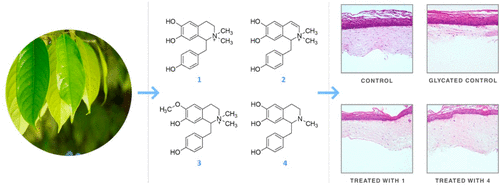当前位置:
X-MOL 学术
›
J. Nat. Prod.
›
论文详情
Our official English website, www.x-mol.net, welcomes your
feedback! (Note: you will need to create a separate account there.)
Advanced Glycation End Product Inhibition by Alkaloids from Ocotea paranapiacabensis for the Prevention of Skin Aging.
Journal of Natural Products ( IF 3.3 ) Pub Date : 2020-03-05 , DOI: 10.1021/acs.jnatprod.9b01083 Larissa de Freitas 1 , Marilia Valli 1, 2 , Alessandra C Dametto 1, 3 , Paula C Pennacchi 4 , Adriano D Andricopulo 2 , Silvya S Maria-Engler 4 , Vanderlan S Bolzani 1
Journal of Natural Products ( IF 3.3 ) Pub Date : 2020-03-05 , DOI: 10.1021/acs.jnatprod.9b01083 Larissa de Freitas 1 , Marilia Valli 1, 2 , Alessandra C Dametto 1, 3 , Paula C Pennacchi 4 , Adriano D Andricopulo 2 , Silvya S Maria-Engler 4 , Vanderlan S Bolzani 1
Affiliation

|
A bioassay-guided study aiming at identifying inhibitors of the glycation process on the leaves of Ocotea paranapiacabensis afforded four benzylisoquinoline alkaloids (1–4), with 1 and 2 identified as new naturals products, while 3 and 4 were previously described in the literature, with 3 being identified as magnocurarine. Purification was performed by column chromatography and high-performance liquid chromatography. The structures of the isolated compounds were elucidated by spectroscopic methods including UV, NMR, and HRMS. The process of skin aging has been recently associated with advanced glycation end products (AGEs), and strategies inhibiting their formation have been addressed by pharmaceutical companies for the development of novel antiaging compounds. Alkaloids 1–4 were evaluated for their potential to inhibit AGE formation and showed inhibition of 62.9%, 83.3%, 26.1%, and 98.2% (150 μM), respectively. The antiaging potential of compounds 1 and 4 were evaluated with a reconstructed human skin model in vitro, and results showed a decrease in dermis contraction (8.7% and 4.2% respectively for 1 and 4) when compared to the glycated control (57.4%). Additionally, absorption, distribution, metabolism, and excretion (ADME) and toxicity properties were predicted using in silico methods, and the results were considered significantly promising for alkaloids 1 and 4 to continue the development of these alkaloids with skincare properties.
中文翻译:

来自 Ocotea paranapiacabensis 的生物碱对防止皮肤老化的高级糖化终产物抑制作用。
一种生物测定引导的研究目的是确定上的叶子上的糖基化过程的抑制剂Ocotea paranapiacabensis得到4种苄基异生物碱(1 - 4),其中1和2确定为新土黄产品,同时3和4在文献中先前所描述的,与3被鉴定为木兰素。通过柱色谱和高效液相色谱进行纯化。分离出的化合物的结构通过光谱方法包括UV、NMR和HRMS进行阐明。皮肤老化的过程最近与晚期糖基化终产物 (AGEs) 相关,制药公司已经解决了抑制其形成的策略,以开发新型抗衰老化合物。生物碱1 - 4为他们的潜在抑制AGE形成分别进行了评价,并表现出62.9%,83.3%,26.1%,和98.2%(150μM)抑制。化合物1和4的抗衰老潜力用体外重建的人体皮肤模型进行评估,结果显示与糖化对照 (57.4%) 相比,真皮收缩减少(1和4分别为 8.7% 和 4.2 %)。此外,使用计算机方法预测了吸收、分布、代谢和排泄 (ADME) 和毒性特性,结果被认为对生物碱1和4继续开发具有护肤特性的生物碱具有重要意义。
更新日期:2020-04-24
中文翻译:

来自 Ocotea paranapiacabensis 的生物碱对防止皮肤老化的高级糖化终产物抑制作用。
一种生物测定引导的研究目的是确定上的叶子上的糖基化过程的抑制剂Ocotea paranapiacabensis得到4种苄基异生物碱(1 - 4),其中1和2确定为新土黄产品,同时3和4在文献中先前所描述的,与3被鉴定为木兰素。通过柱色谱和高效液相色谱进行纯化。分离出的化合物的结构通过光谱方法包括UV、NMR和HRMS进行阐明。皮肤老化的过程最近与晚期糖基化终产物 (AGEs) 相关,制药公司已经解决了抑制其形成的策略,以开发新型抗衰老化合物。生物碱1 - 4为他们的潜在抑制AGE形成分别进行了评价,并表现出62.9%,83.3%,26.1%,和98.2%(150μM)抑制。化合物1和4的抗衰老潜力用体外重建的人体皮肤模型进行评估,结果显示与糖化对照 (57.4%) 相比,真皮收缩减少(1和4分别为 8.7% 和 4.2 %)。此外,使用计算机方法预测了吸收、分布、代谢和排泄 (ADME) 和毒性特性,结果被认为对生物碱1和4继续开发具有护肤特性的生物碱具有重要意义。











































 京公网安备 11010802027423号
京公网安备 11010802027423号